We use cookies to ensure you get the best experience on our website. More Info.
How to choose your SUP (Stand Up Paddle)
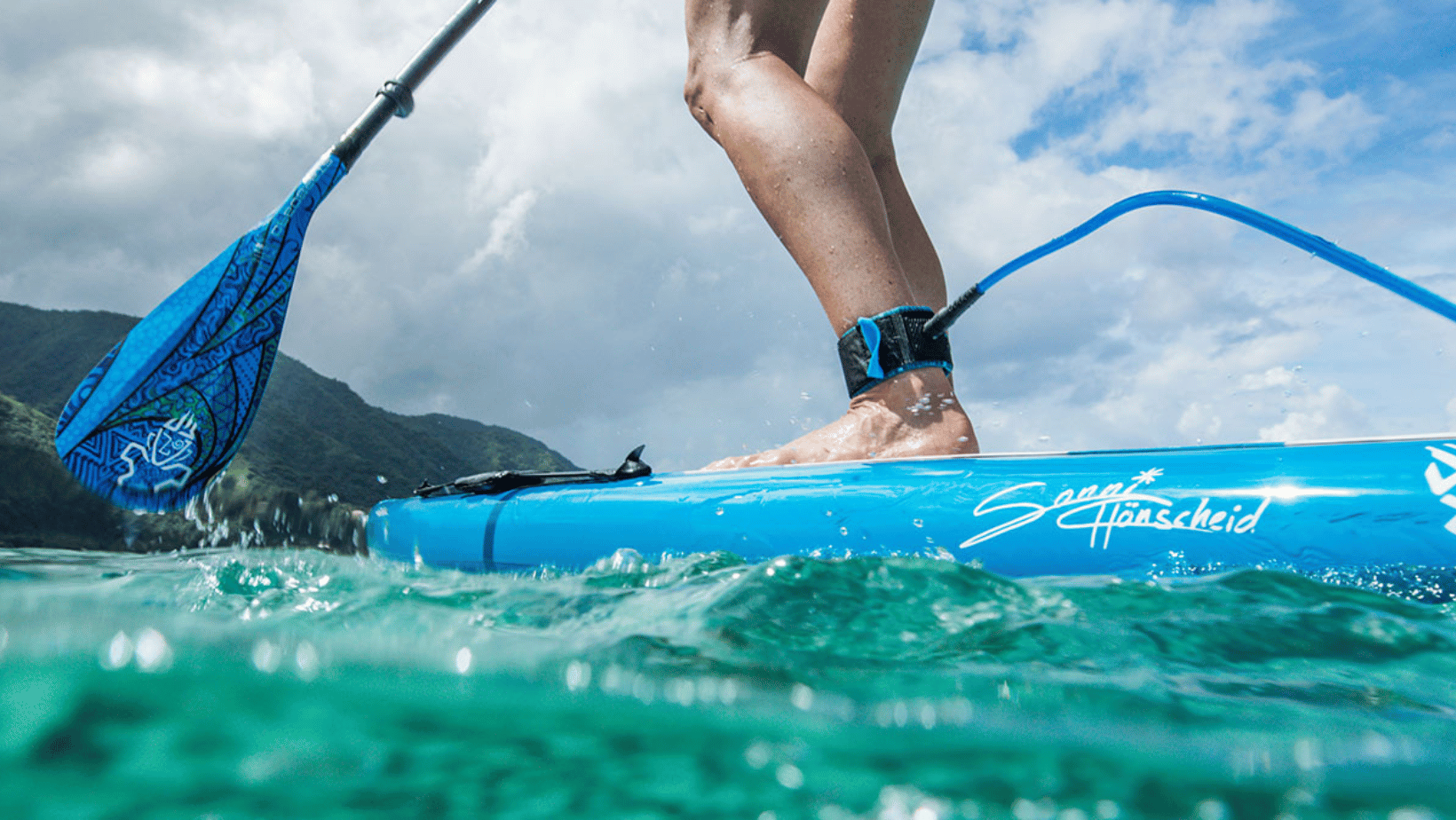
*This page is linked to the "Choose your SUP Paddle" guide page. If you want to get the perfect board and paddle for your outings, be sure to read the information available on the 2 pages.*
The stand up paddle (SUP) is a water sport where the practitioner is standing on a board longer and wider than a traditional surfboard, pushing himself with a paddle.
This sport was born in the 1960s in Hawaii but was quickly overtaken by the arrival of short boards. He came back to the fore at a competition in Hawaii (again), organized in 2004.
- Rigid or inflatable SUP?
- How to choose your SUP (Stand Up Paddle)?
- How to practice the SUP?
- How to get up on your SUP?
- How to paddle well in SUP?
- How to inflate your SUP?
- Which inflatable SUP to choose?
- Which size of SUP to choose?
- How to transport your SUP?
- Which fin to choose for your SUP?
- How to maintain your SUP?
1. Rigid or inflatable SUP ?
Brands are developing more and more inflatable boards.
Storage and transport: inflatable advantage
This is the very strong point of the inflatable SUP, they can deflate, the board held easily in a backpack. In addition, inflatable SUPs are generally sold with a telescopic or removable paddle.
Yes, it's a big backpack and it weighs its weight... but:
- You can put 4 boards in the trunk of your car.
- If you do not have a garage, it will be easier to find a place in your home.
- Perfect for traveling by boat or plane without any problem.
Of course, if you have a double garage, you ride in an extended van and you live within 5 minutes of the spots, these criteria do not really apply to you.
Robustness: inflatable advantage
Inflatable SUPs are much stronger than rigid boards especially in shock and crushing. No problem paddling on the rails. No stress if you lend it to your children.
This robustness explains the success of the inflatable SUP in wild water, where we always end up touching the bottom or let his board go in the pebbles...
On the other hand inflatable involves punctured. Watch out for brambles, hooks, knives or other sharp objects. You may prefer a rigid SUP to go fishing.
Versatility and performance: rigid SUP advantage
Although the inflatable SUP market is in full development and almost all SUP brands now offer inflatable models, the diversity of the offer remains poor.
Inflatable SUP construction techniques greatly limit the design of boards.
Designers can only choose a length and slightly modulate the outline (line view from above) and the rocker (line profile view).
Conversely, rigid SUPs are constructed from a styrofoam that can be sculpted to the smallest detail. This allows all possibilities a fine work of the hull, rails, outline, rocker, bridge...
In short, the possibilities are incomparable and performance on arrival too.
Fins management: rigid SUP advantage
All rigid SUPs have removable fins that can be adjusted and/or changed to change the board's behavior. (which is an advantage)
On the inflatable side, there are two styles: the indestructible approach with flexible and fixed fins (perfect for the river and children) and the performance approach with removable rigid fins. (It will be necessary to pay attention to this point according to its program at the time of the purchase).
2. How to choose your SUP (Stand Up Paddle)?
To avoid finding yourself with an unsuitable board, it will be necessary to choose a board that corresponds to your size, your level, your program and your storage possibilities.
Below our tips to help you choose according to your size:
- Basic rule for stability: The choice of volume and width of your SUP depends on your weight. The higher it is, the larger the volume and width of the SUP would be.
- Beware of excesses: a small rider will have trouble paddling on a board too wide for him. A too large SUP may be too heavy/cumbersome.
- If you are looking for a SUP that will be used by more than one person, it is better to opt for a larger model: a small rider can always use a large board, but the opposite would not work.
- The thickness of an inflatable is even more important than all other dimensions (length and width) because it has not only an effect on the flotation, but also on the rigidity - everyone needs and wants their paddle to be the more rigid possible. Thick boards are stiffer, but too thick construction reduces responsiveness.
The RSS system (Rocker Stiffing System) by Red Paddle: by inserting slats in sheaths on the side of the board they are able to increase the rigidity of boards up to 40%. For example, a board of 100mm would have the same rigidity as a board of 120 mm retaining the maneuverability of a board of 100mm.
Then, our advice to help you choose a SUP board according to your level and program, there are eight main categories of SUP boards: allround (multipurpose), touring (hiking), race, yoga, river, fishing , windsurf and wave (or surf):
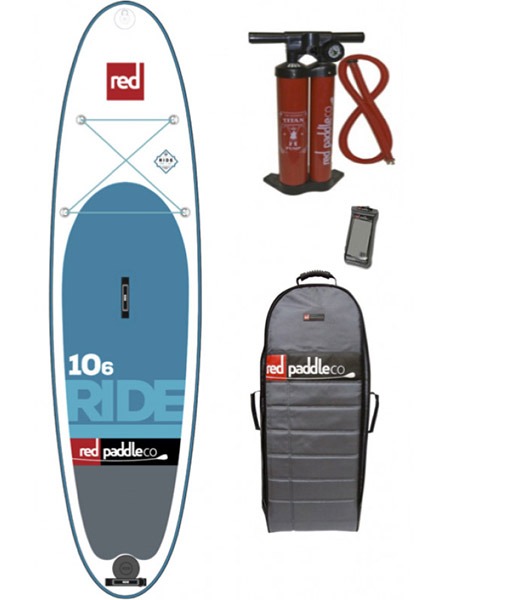 |
1) Allround :These versatile models are designed to navigate in all conditions. They are suitable for beginners because they allow to discover all the activities of the SUP on a single board. They have enough width to ensure good stability, good glide and good directivity on flat water or at sea. Their rocker (longitudinal curve) adapted in general allows good surfing performance. |
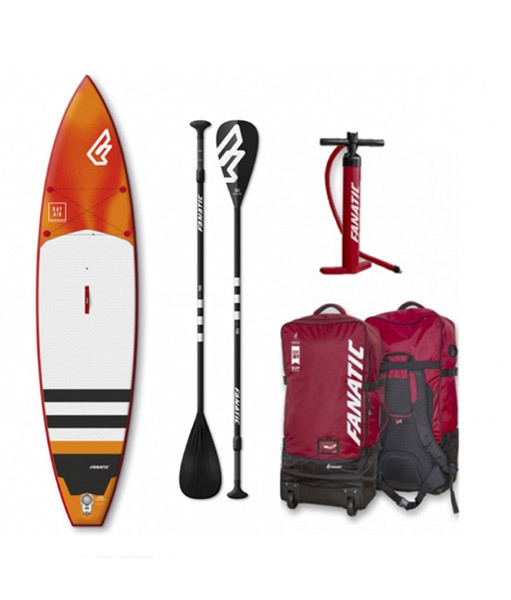 |
2) Touring :These boards are designed for long hikes on flat water and on the sea in downwind. They are generally quite wide (for stability) and long for more speed and more directivity. Their front is often pointed and has a V-shaped hull at the front to slide straight and not hit the chop face. Stable enough, these boards can be used by beginners |
 |
3) Race :Race boards are primarily designed to go fast with the basic idea that the longer it is, the more it slips, the faster it goes. Race SUPS have standard lengths of 12'6 or 14 '(14 feet). In competition, the 12'6 is the most widespread class. So if you want to line up on races, this is the best choice. The shorter a race SUP is (and the heavier the hull is round) the faster it goes (because less wet surface) but the less stable it is. A narrow SUP also allows rowing more efficiently because it is less sway to position his paddle vertically.
|
 |
4) Yoga :SUP Yoga are boards for those who want to combine the pure pleasure of paddling and yoga. These boards are normally larger, more stable and equipped with an elastic system. Yoga SUP will help maintain balance and postures on flowing water such as the ocean or lake. |
 |
5) River :The River SUP are very durable, stable SUPs with specific fins that last in all your wild water races, extreme or not. |
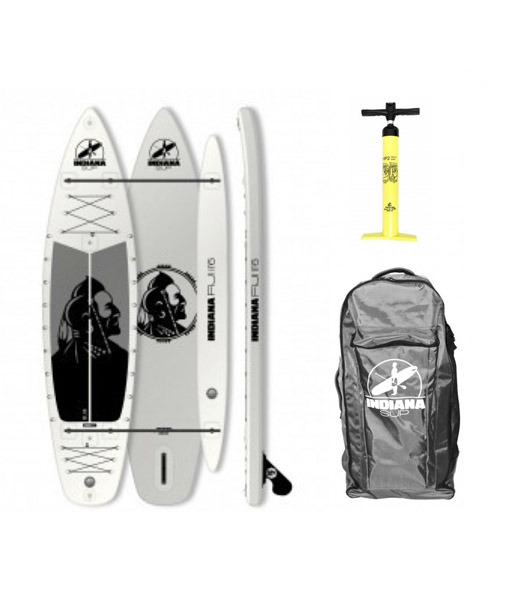 |
6) Fishing :Paddle boards designed for fishing with optimized length and width boards. These SUPs are very stable so you can fish and use many fishing rods at the same time. |
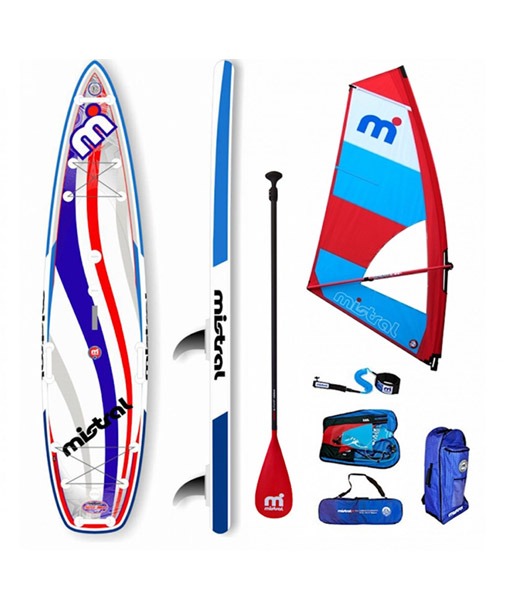 |
7) Windsurf :This is an option found on some allround boards equipped with a mast footbox that can mount a windsurf rig. |
 |
8) Wave-surf :Boards designed specifically for surfing are often short, show a narrower nose and tail (back) and more rocker (curve). These features make them more maneuverable in waves, but also slower and less directional on flat water. They are also less stable. |
3. How to practice the SUP?
| __ | Before learning how to paddle, it is important to familiarize yourself with your SUP equipment before you jump into the water. This video also demonstrates one of the most important paddle board techniques – the prone position. This position is used when launching and landing, as well as for rescue and also if we have any problems on the water. Once the basics of prone have been learnt you can progress to paddling on your knees. |
Then the best start is to kneel on the board, especially if the launch is close to a pontoon to avoid falling on the edge. Start paddling on your lap and as soon as you feel a little more comfortable, put your shoulders to the front of the board by leaning on the paddle you lay flat on the board in front you. Keep your legs bent and your feet well apart for a good balance. Put one hand on the handle of the top of the paddle, the other on the shaft and begin to paddle with the blade of your paddle open towards the front of the board. Try to sink the blade into the water by planting it as far forward as possible and take it out of the water at your feet. That's it, you know how to paddle !
| __ | ||
|
Stand up and find your balance. Here we are looking at the basics of the paddle, the basis of everything else to come. |
Once you have the basics, we can begin to refine these techniques. Better paddle placement, more power and better driving in a straight line. |
4. How to get up on your SUP?
Start by putting your board in the water by your side, lie on it by putting the paddle below you, the palm at the level of the torso and the handle raised to the front. Paddle in surfer position by moving away from the edge.
Take the paddle in one hand and kneel in the center of the board, not too far forward or too far back.
It is time to get up, put your paddle perpendicular to the board and put your two hands on it, facing you. Raise one knee, then the second by spreading your feet well, you can use the paddle to keep your balance.
You can also move from kneeling position to standing position by standing up at once.
Finally to keep this balance, look far ahead and especially not the board, keep a slightly bent position on your SUP.
5. How to paddle well in SUP?
There are some basic philosophies on the technique and art of paddling SUP, but it all revolves around using the paddle as a lever. Your upper hand will operate the lever and the lower hand will act as a fulcrum. With this in mind, we offer the following tips and tricks:
- Keep your lower arm straight and relatively still,
- Pull your upper arm towards your body to extend the paddle forward,
- Rotate your upper shoulder forward and extend your reach,
- Insert the paddle into the water as far forward as possible and dive there in the water (not fully under!),
- The paddle must be put in the water in front of you and come out of the water when it reaches the level of your feet. There is no need to go further, you risk to losing speed,
- To stay in a straight line, give a few strokes on one side and then move to a few strokes on the other. Always remember to change the position of your hands when you change sides,
- Then come the moment to turn, to do so place the paddle in the water on the right side (to turn left). At the same time, turn your torso to the left and keep a low position and pull to the right, towards the tail (the back of the board) with the paddle, while leaning to the left with your torso. You will feel the SUP move quickly to the left.
6. How to inflate your SUP?
- Put the check valve firmly on the SUP, make sure that the central pin is elevated,
- Connect the hose to the valve and turn a quarter of a turn (you really have to "plant" the hose by pushing against the central pin),
- Do not forget to lock your pump using the latch on the pump (if later your board is more difficult to inflate, you can remove the latch),
- Start pumping, do not hurry you have plenty of time,
- When pumping becomes more difficult, finish by giving small strokes of pump while keeping the arms extended and using the weight of your body,
- Be attentive to noises. If you hear a sound of deflation, adjust your pump again so that it is water-resistant
- When you are finished, remove the hose and put the plug back in place, your SUP is ready! (If the recommended pressure is not indicated and you have a pressure gauge on your pump, inflate your board to about 15 PSI).
It takes at least 5 minutes while inflating with a good pump.Between 2 sessions, it is important not to leave your SUP over inflated. If you prefer to keep it inflated, release some pressure at the end of your session
A properly inflated SUP should not warp under the effect of your weight.
A board thus deformed will have several problems; the SUP will be unstable, you will have a hard time holding on and the board will have a very bad slide, its banana shape will not allow you to progress on the water.
There is also the possibility to inflate your inflatable SUP with an electric pump or a compressor, for compressors we have the RED PADDLE electric pump adaptors for you to inflate your SUP without worries!
7. Wich inflatable SUP to choose?
The choice of your inflatable stand up paddle board (also called iSUP) is related to the practice you will do. Depending on whether you are going to ride waves or participate in races, the paddle board you choose will not be the same at all. If like most people, you want to practice during your free time to relax, there will be again another board you need.
Many people are turning to the inflatable SUP for the obvious benefits of its size once the board deflates. If this advantage is valid for all models, there are some thoughts to know before your choose your SUP.
The dimensions of a board is determined by the 4 criteria that are the length, the height, the thickness and the hardness of the board. These 4 criteria give the overall volume of a board, which is a good indicator to choose one (the bigger the board, the easier and more stable it will be).
LENGTH
This is a very important parameter because the length directly affects the handling of your board. The shorter the board, the easier it will be to use, maneuverable and responsive to every paddle stroke. In the opposite case, the longer the board, the faster it will be, comfortable but difficult to maneuver.
- 12'6" or more: For hiking or participating in races
- Between 9'5" and 12": For a family all-terrain board
- Between 8'' and 9'5" : For an all-terrain board for lightweight people
- Between 9" and 10": For wild water
HEIGHT
In the SUP market, the most common board width is 30’’ (76cm). This width is found in most brands. There exist wider board that make it more stable for people who's heavier than 100kg. The more a board is narrow and the more the penetration into the water will be efficient (more speed) and the longer a board is, the more stable it will be, but beware, the equivalent width of an inflatable SUP will often be less stable than a rigid SUP!
- Experts paddle on boards between 24 "and 27" wide
- The XS morphologies should paddle on boards from 28" to 29" maximum to get a good paddling motion
- Standard morphology (M-L) is normally quite stable on a 32" board under standard conditions
- An XL morphology should be able to fish on a 35" board
- There are larger widths making the board more stable for morphologies greater than 100kg
THICKNESS
The thickness of an inflatable SUP board is important both on inflatable and rigid. We find today on the market 3 types of thickness for inflatable stand up paddle:10cm (4"), 12cm (4'8') et 15cm (6").
- The thicker a board is, the more rigid it becomes at equivalent pressure
- The thicker a board is, the more wind it catches
- The thicker a board is, the more volume it has (for the same width and length) and the longer it will be to inflate
- The 10 cm thick i-SUP boards are suitable for beginner to intermediate levels for people who are less than 85 kg
- For morphologies over 90kg, a thickness of 15cm is strongly recommended
HARDNESS
This variable is only interesting on an inflatable Stand Up Paddle. The hardness of a board is related to several parameters like the shape of the board, the quality of the fabric, the construction, the number of layers and the density of the filaments in the Drop-stitch ect ...
The hardness is related to several parameters, it is difficult to details it and unfortunately brands and manufacturers do not give enough information.What is important to remember is that the more the board will be "hard", the more stWe can not approach the hardness of a board without addressing the methods of building an i-SUP, but before that...
The Drop Stitch, what is that?
Inflatable SUPs are built from Drop Stitch technology, this is the heart of the inflatable board.
This technology consists in assembling two PVC membranes between which thousands of regularly spaced polyester threads have been woven (unfortunately for us, the brands never communicate on the filament densities). This mesh between the two membranes (also called "skins" or "layer") allows to retain the air by keeping the flat shape of the SUP despite the pressure, without this mesh, your board would look like a big balloon.
The Drop Stitch allows your board to have the right shape. A good Drop Stitch will have a denser mesh, composed of more threads between the two skins, the board will accept more pressure, and so we can over-inflate it without the risk of tearing it.
Specifically, a normal Drop Stitch inflates to 15 PSI (12 for the worst), while a quality Drop Stitch will accept a pressure of up to 25 PSI (good luck for succeed to reach this pressure). A Drop Stitch of quality will deform less because the construction having more threads, the air will be distributed in a more homogeneous way. A board with a poor Drop Stitch quality will have imperfections and bumpsin in the worst case.
In summary, Drop Stitch is the polystyrene core of the rigid board. But like a rigid board whose foam core is not the core of the construction, Drop Stitch alone does not define the quality of a SUP, what surrounds it is also important.
a. Single Layer
Single layer construction involves using the Drop Stitch as it comes out of the factory: 2 layers of PVC which threads are woven in between.
As there are different qualities of Drop Stitch, there are different qualities of single layer boards. Some constructions are correct while others are mediocre, this is the case for the first prize boards found in supermarkets.
Today, the vast majority of boards sold are single layer because they are suitable for occasional Stand Up Paddle user.
- Advantages: Lightweight and cheap
- Disadvantages: risk of porosity, very fragile (frequent leaks, board that pierces more easily), soft board and poor performance
If you choose a single layer iSUP for economic reasons, Sportmania advises you to choose at least a paddle that its more than 3m and 15cm thick.
b. Double Layers
It is a single layer board that is inflated, and on which it sticks a second none-stretched skin on the first skin that is stretched. This second unstretched skin plays a role of sealing, resistance and rigidity.
This construction is much more reliable, the two PVC membranes and the glue ensure a perfectly sealed structure. The only problem is that sticking a second layer on a first membrane adds a significant weight to the board.
- Advantages: Less risk of porosity, more solid, more rigid
- Disadvantages: Heavier, medium finishes with bubbles and folds, more expensive (this construction requires more materials and a lot of labour).
c. Hybrid
This is a single layer board that is inflated, and on which we stick another PVC strip at the rails. This extra skin strip is named "stringer".
- Advantages: lightweight, mid-range price, a little less risk of porosity, recommended for lightweight people
- Disadvantages: quite fragile, board always soft and inefficient (some brands compensate the lack of rigidity by putting thicker drop stitch, unattractive and unmanageable)
d. Fusion
The Fusion construction is a recent innovation available on the market only since 2016.
First available exclusively at Red Paddle and Fanatic, this innovation spreads from 2017 to other high-end brands. Fusion technology revolutionizes the construction of iSUP, the second layer of PVC is fused to the manufacturing with the first non-inflated layer.
This fusion of the two skins is done using a large microwave (the two layers are not glued and we save on the weight of the glue), we ended up stabilizing everything with epoxy threads who are inserted between the two skins.
The second skin fused on the first, is as tight as the first during inflation. There are therefore two outstretched skins instead of one, and this offers considerable stiffness and resistance to torsion.
- Avantages : clean and constant finishes (no folds, no bubbles), boards much lighter thanks to the abandonment of the glue (20% lighter approximately), boards much more rigid (thanks to the tension of the 2 skins), more rigid than a double layer board, all the threads between the two skins are tend when inflate (as they are on the periphery and they surround the boards, they stiffen even more the board and offer you an incredible resistance to the torsion)
- Inconvénients: its high prices
There are also 2 new types of unique innovation, specific to Red Paddle and Staboard SUP. Their goal is to optimize the rigidity of their boards and their speed.
- The FFC system (Forward Flex Control) is a patented innovation that stiffens the front of the board with a compression strut. The FFC eliminates the flex that can occur during the race and also increases the overall speed of the board.
- The RSS system (Rocker Stiffening System) consists of two reinforcement slats that slide into the side pockets of the boards. On the Elite boards (Red Paddle), the RSS is combined with the FFC system to ensure rigidity during gliding.
- The Airline Technology is the most advanced Starboard's technology in the adjustment of rocker lines and deflection (unique system to this brand!). This efficient and lightweight technology has the potential to change the future of inflatable stand up paddle boards. The free floating aramid cable locks the shape of the board when inflated, creating a solid and reliable shell feel. Patented aerial technology uses a predefined floating cable. It is attached to the nose, passes under the bottom and ends at the fin box. he predefined cable is slightly shorter than the board. So when the card is inflated, it is subjected to tension and considerably stiffens the board.
8. Which size of SUP to choose?
Small reminder of some important points before choosing the right SUP...
- The choice of volume and width of your SUP will depend on your weight. The higher it is, the larger the volume and width of the SUP will be.
- A small rider will have a hard time paddling on a board that is too big and may be too heavy/cumbersome for him.
- If you are looking for a SUP that will be used by many people, be smart and opt for a bigger model: a small rider can always use a large board, not the opposite!
- The thickness of an inflatable is even more important than all other dimensions (length and width) because it has not only an effect on the flotation, but also on the rigidity - everyone needs and wants his paddle to be the more rigid possible. Thick boards are stiffer, but too thick construction reduces responsiveness.
| 10' - 10'8" | 11' - 11'6" | 12' - 12'6" | < 14' | |
| USE | ||||
| Short ride | ||||
| Long ride | ||||
| Race | ||||
| Multi person | ||||
| .GA | ||||
| MORPHOLOGY | ||||
| Light | ||||
| Middle | ||||
| Heavy |
* This board is for information only. It's better to contact directly the SPORTMANIA shop for any additional help (type of SUP, conditions of use, etc.)
9. How to transport your SUP?
There are several ways to transport your board, we separated them into 2 categories to make your job easier:
a. For short rides:
- The carrying handle: The most basic way to carry your paddle, grab the central handle, lift your board and you're ready to go.
- The carrying strap With the paddle in one hand, lift the board from the tail with the nose to the ground. Walk to the center of the board and move the weight of the board to balance on your head. You can then move the board to balance your shoulder. To replace the board, simply follow the steps in reverse order.
- Transport trolleys: Transport trolleys are perfect for small to medium distances. On foot or by bike, they make it easier and faster for you to move to concrete to the sand!
b. For long rides:
- Car Roof Racks or Rack Pad: Rigid paddles can be attached to any vehicle with car mounts. Most flexible surfboard mounts fit an SUP board. If your vehicle is already equipped with a rack system, you can also use straps to attach boards to existing racks. Some racks even have locking devices to protect you from theft. Many people simply throw a towel over the car and pass straps through the doors.
10. Wich fin to choose for your SUP?
On the inflatable side we found 2 style of fins: the indestructible approach with flexible and fixed fins (it's perfect for the river and children) and the performance approach with removable rigid fins. (It will be necessary to pay attention to this point at the moment of the purchase).
a. Glued fins
The fins are made in quite flexible plastic and are directly glued to the board.
- Advantage: very robust, simple, no setting, no adjustment, no risk of losing a fin.
- Disadvantage: no possibility to change the fins for others more efficient, no possibility of adjustment; the fins tend to become deformed when the board is folded (it's enough to heat them with a hair dryer to restore them to their original shape)
b. Key fins
- Avantage: cheap
- Disadvantage: fragile, innefficient.
c. Zipper fins
- Avantage: robust and lightweight, attachment without tools.
- Disadvantage: no adjustment, little fin choice, the fin can be difficult to set up or remove (beware of foreign objects in the slide ...).
d. US fins
It is the "high-end" solution. The US housing is the most standard fin fixing system. It can be found on windsurf boards, surfboards typed longboard, most rigid SUP and inflatable SUP of quality.
- Avantage: a very large choice of fins adapted for each practice (wild water, race, ride, surf).
- Disadvantage: you have to put a few more coins
11. How to maintain your SUP?
